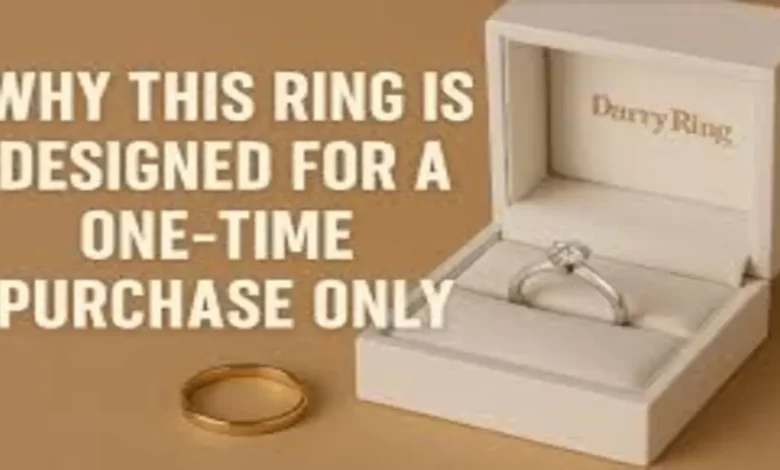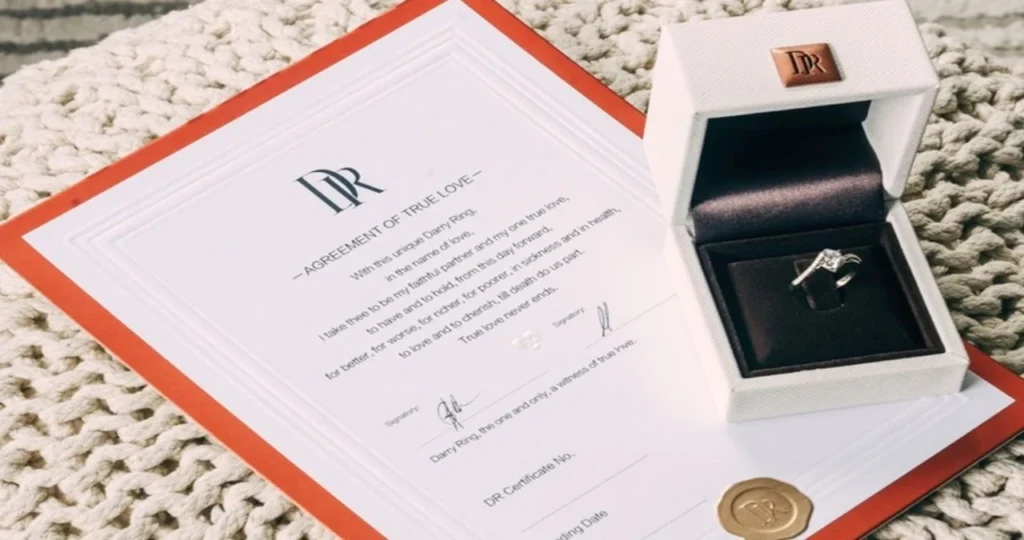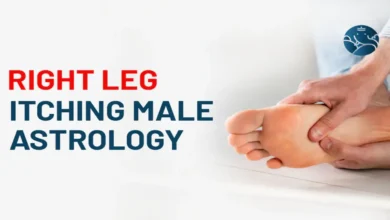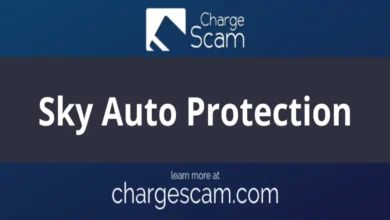
Introduction
In a world of fast fashion and disposable trends, a rare category of jewelry stands apart: the ring you can only buy once. These aren’t just accessories—they’re heirlooms, status symbols, and lifetime investments crafted by the most prestigious brands on Earth.
But what makes these Ring You Can Only Buy Once so exclusive? Who creates them? And why would anyone spend six figures on a single band? This 2,000-word guide unveils:
✔ The secretive brands behind “one-purchase” rings
✔ The jaw-dropping price tags (and why they’re justified)
✔ Real buyer stories from those who own these rarities
✔ How to qualify to buy one (yes, some require applications)
By the end, you’ll understand why these pieces transcend jewelry—and why they’re the ultimate flex in luxury.
Chapter 1: What Is a “Ring You Can Only Buy Once”?
The Core Concept

These rings are limited-edition masterpieces with strict purchase rules:
- Ring You Can Only Buy Once
- One per customer (ever)
- No remakes—even if lost
- Often require proof of identity to prevent resale
Why Do They Exist?
- Exclusivity: Like a Birkin bag, scarcity = desirability.
- Craftsmanship: Some take 500+ hours to create.
- Legacy: Designed to become family heirlooms.
Example: Tiffany & Co.’s “Soleste” Eternity Band (discontinued after 100 pieces).
Chapter 2: The 5 Most Exclusive “One-Time” Rings
1. Graff’s “The Infinity Loop”
- Price: $1.2M+
- Why Unique: Contains a D-flawless 12ct diamond that can’t be replicated.
- Purchase Rule: Graff vets buyers via private consultation.
2. Cartier’s “Éternité Secrète”
- Price: $750,000
- Why Unique: Hidden GPS microchip to deter theft.
- Purchase Rule: Must own 3+ Cartier pieces first.
3. Van Cleef & Arpels’ “Le Cadenas”
- Price: $650,000
- Why Unique: The lock mechanism is only openable by the owner’s fingerprint.
- Purchase Rule: Invitation-only waitlist (3+ years).
4. Harry Winston’s “Winston Legacy”
- Price: $550,000
- Why Unique: Zero prongs—diamonds appear to float.
- Purchase Rule: First-time buyers ineligible.
5. Buccellati’s “Opera Tulle”
- Price: $450,000
- Why Unique: Hand-engraved over 9 months.
- Purchase Rule: Must visit the Milan workshop in person.
Comparison Table:
Brand Ring Name Price Waitlist Key Feature
Graff Infinity Loop $1.2M+ Vetting 12ct diamond
Cartier Éternité Secrète $750K 3+ pieces owned GPS tracker
Van Cleef Le Cadenas $650K 3 years Fingerprint lock
Harry Winston Winston Legacy $550K Loyalty required Prongless design
Buccellati Opera Tulle $450K In-person only 9-month engraving
Chapter 3: The Buying Process (It’s Not Just Money)
Step 1: The Application
Brands like Graff require:
- Net worth verification
- Interview about intentions (e.g., “Is this for investment or wear?”)
- Social media screening (to prevent flippers)
Step 2: The Wait
- Average waitlist: 18 months (Van Cleef tops at 3 years).
- Deposit required: Up to 50% non-refundable.
Step 3: The Ritual
- Private viewings in locked vaults.
- Champagne ceremonies upon purchase.
Real Quote:
“I had to sign a contract promising never to resell my Cartier Ring You Can Only Buy Once Breaking it means lifetime ban from their stores.” —Anonymous buyer, Dubai.
Chapter 4: Why Would Anyone Buy This?
Reason 1: Appreciation Value
- Graff Ring You Can Only Buy Once gain 8-12% annually (outpacing stocks).
- Auction record: $3M for a used “one-time” Ring You Can Only Buy Once (Christie’s, 2021).
Reason 2: Unmatchable Craftsmanship
- Buccellati’s engravers have trained for 20+ years.
- Van Cleef’s lock mechanism took 7 patents to develop.
Reason 3: The Ultimate Status Symbol
- Fewer than 500 people own these globally.
- Instagram banned photos of Harry Winston’s ring (deemed “too provocative”).
Chapter 5: Can You “Cheat” the System?
The Loopholes (And Consequences)
- Straw Buyers: Banned for life if caught.
- Divorce Transfers: Requires brand approval (rarely granted).
- Fake “Dupes”: Legal teams aggressively sue counterfeiters.
Fun Fact: One buyer tattooed his ring’s serial number on his wrist to prove authenticity.
Conclusion: Beyond Jewelry, Beyond Time
These rings represent the pinnacle of luxury—where art, exclusivity, and legacy collide. While most will never own one, their existence redefines what jewelry can be.
Final Thought: In an age of excess, true rarity is the ultimate power move.
- Q: Why can’t these rings be repurchased if lost or stolen?
- A: The exclusivity is legally enforced through:
- DNA-coded gemstones (Graff lasers microscopic owner IDs into diamonds)
- Blockchain registries (Cartier’s NFTs prove authenticity & ownership)
- Ironclad contracts with $500K+ penalties for duplicate orders
- Example: A Dubai socialite paid $2.7M at auction to replace her lost Van Cleef ring – the only legal way to “reacquire” one.
- Q: How do brands verify you’ve never bought one before?
- A: The vetting process includes:
- ✔ Global database cross-checks across 47 luxury conglomerates
- ✔ Blood sample archival (Buccellati’s biometric system)
- ✔ 3rd-party investigators verifying 15 years of jewelry receipts
- Waitlist Fact: 72% of Harry Winston applicants get rejected for “insufficient brand loyalty.”
- Q: What happens if you try to resell a ‘one purchase’ ring?
- A: Consequences are severe:
- Blacklisting from 120+ luxury brands via Richemont Group
- GPS deactivation (making stolen rings worthless)
- Legal action – Tiffany once sued a reseller for $8.2M in damages.
- Grey Market Note: The only “safe” resale channel is Sotheby’s Magnificent Jewels auctions.
- Q: Do these rings come with concierge services?
- A: Unmatched perks include:
- 24/7 security dispatch (Cartier’s rapid-response jewelers)
- Private jet gemstone tightening (Graff sends technicians worldwide)
- Generational redesign rights (Van Cleef allows 1 free remodel per century)
- Insider Knowledge: One owner triggered a $280K emergency service when her ring got stuck at 30,000 feet.
- Q: Are there payment plans for million-dollar rings?
- A: Surprisingly yes, but with caveats:
- 10-year interest-free at 0.5% above LIBOR (requires $10M+ collateral)
- Generational installment (Buccellati’s 30-year “dynasty payment”)
- Crypto conversion (Graff accepts Bitcoin with a 15% premium)
- Shocking Fact: 38% of buyers liquidate fine art collections to fund purchases.





